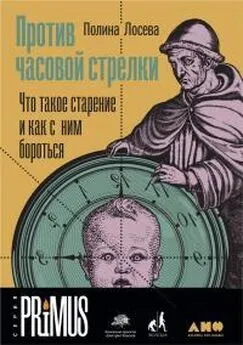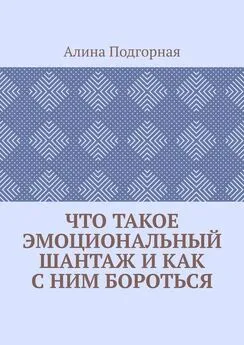Полина Лосева - Против часовой стрелки. Что такое старение и как с ним бороться
- Название:Против часовой стрелки. Что такое старение и как с ним бороться
- Автор:
- Жанр:
- Издательство:Альпина нон-фикшн
- Год:2020
- Город:Москва
- ISBN:978-5-0013-9314-6
- Рейтинг:
- Избранное:Добавить в избранное
-
Отзывы:
-
Ваша оценка:
Полина Лосева - Против часовой стрелки. Что такое старение и как с ним бороться краткое содержание
В своей книге биолог и научный журналист Полина Лосева выступает в роли адвоката современной науки о старении и рассказывает о том, чем сегодня занимаются геронтологи и как правильно интерпретировать полученные ими результаты. Кто виноват в том, что мы стареем? Что может стать нашей защитой от старости: теломераза или антиоксиданты, гормоны или диеты? Биологи пока не пришли к единому ответу на эти вопросы, и читателю, если он решится перейти от размышлений к действиям, предстоит сделать собственный выбор.
Эта книга станет путеводителем по современным теориям старения не только для биологов, но и для всех, кому интересно, как помочь своему телу вести неравную борьбу со временем.
Против часовой стрелки. Что такое старение и как с ним бороться - читать онлайн бесплатно ознакомительный отрывок
Интервал:
Закладка:
Goldsmith T. C. Evolvability, population benefit, and the evolution of programmed aging in mammals // Biochemistry (Moscow)/2015 Dec; 82: 1423–1429.
568
Bredesen D. E. The non‐existent aging program: how does it work? // Aging Cell. 2004 Sep; 3 (5): 255–259.
569
Gavrilova N. S., Gavrilov L. A., Severin F. F., Skulachev V. P. Testing predictions of the programmed and stochastic theories of aging: Comparison of variation in age at death, menopause, and sexual maturation // Biochemistry (Moscow). 2012 Jul; 77: 754–760.
570
Skulachev V. P. Aging is a specific biological function rather than the result of a disorder in complex living systems: biochemical evidence in support of Weismann's hypothesis // Biochemistry (Moscow). 1997 Nov; 62 (11): 1191–1195.
571
Longo V. D., Mitteldorf J., Skulachev V. P. Programmed and altruistic ageing // Nature Reviews Genetics. 2005 Nov; 6: 866–872.
572
Skulachev M. V. & Skulachev V. P. New data on programmed aging – slow phenoptosis // Biochemistry (Moscow). 2014 Oct; 79: 977–993.
573
Zhao Y. Naked mole rats can undergo developmental, oncogene-induced and DNA damage-induced cellular senescence // PNAS. 2018 Feb; 115 (8): 1801–1806.
574
Bradley A. J., McDonald I. R., Lee A. K. Stress and mortality in a small marsupial ( Antechinus stuartii , Macleay) // General and Comparative Endocrinology. 1980 Feb; 40 (2): 188–200.
575
Terry D. F. et al. Lower all‐cause, cardiovascular, and cancer mortality in centenarians' offspring // Journal of the American Geriatrics Society. 2004 Nov; 52 (12): 2074–2076.
576
Kaplanis J. et al. Quantitative analysis of population-scale family trees with millions of relatives // Science. 2018 Apr; 360 (6385): 171–175.
577
Ruby J. G. et al. Estimates of the heritability of human longevity are substantially inflated due to assortative mating // Genetics. 2018 Nov; 210 (3): 1109–1124.
578
Gavrilov L. A., Gavrilova N. S., Olshansky S. J., Carnes B. A. Genealogical data and the biodemography of human longevity // Social Biology. 2002; 49 (3–4): 160–173.
579
Yahin A. I. et al. Genetics of aging, health, and survival: dynamic regulation of human longevity related traits // Frontiers in Genetics. 2015 Apr; 6: 122.
580
Hjelmborg J.vB. et al. Genetic influence on human lifespan and longevity // Human Genetics. 2006 Feb; 119: 312.
581
Van Den Berg N. et al. Longevity defined as top 10 % survivors and beyond is transmitted as a quantitative genetic trait // Nature Communications. 2019 Jan; 10: 35.
582
Austad S. N. & Fischer K. E. Sex differences in lifespan // Cell Metabolism. 2016 Jun; 23 (6): 1022–1033.
583
Franceschi C. et al. Do men and women follow different trajectories to reach extreme longevity? // Aging Clinical and Experimental Research. 2000; 12: 77–84.
584
Hoogendijk E. O. et al. Sex differences in healthy life expectancy among nonagenarians: A multistate survival model using data from the Vitality 90+ study // Experimental Gerontology. 2019 Feb; 116: 80–85.
585
Foo Y. Z., Nakagawa S., Rhodes G., Simmons L. W. The effects of sex hormones on immune function: a meta‐analysis // Biological Reviews. 2016 Jan; 92 (1): 551–571.
586
Arsenović-Ranin N. et al. Influence of aging on germinal centre reaction and antibody response to inactivated influenza virus antigens in mice: sex-based differences // Biogerontology. 2019 May; 20: 475–496.
587
Horstman A. M., Dillon E. L., Urban R. J., Sheffield-More M. The role on androgens and estrogens on healthy aging and longevity // The Journals of Gerontology: Series A. 2012 Nov; 67 (11): 1140–1152.
588
Min K.-J., Lee C.-K., Park H.-N. The lifespan of Korean eunuchs // Current Biology. 2012 Sep; 22 (18): R792–R793.
589
См. п. 153.
590
Davis E. J., Lobach I., Dubal D. B. Female XX sex chromosomes increase survival and extend lifespan in aging mice // Aging Cell. 2018 Dec; 18 (1): e12871.
591
Dehbi A. Z. A., Radstake T. R. D. J., Broen J. C. A. Accelerated telomere shortening in rheumatic diseases: cause or consequence? // Expert Review of Clinical Immunology. 2013; 9 (12): 1193–1204.
592
Atzmon G. et al. Genetic variation in human telomerase is associated with telomere length in Ashkenazi centenarians // PNAS. 2010 Jan; 107 (suppl 1): 1710–1717.
593
Soerensen M. et al. Genetic variation in TERT and TERC and human leukocyte telomere length and longevity: a cross‐sectional and longitudinal analysis // Aging Cell. 2011 Dec; 11 (2): 223–227.
594
Criscuolo F., Smith S., Zahn S., Heidinger B. J., Haussmann M. F. Experimental manipulation of telomere length: does it reveal a corner-stone role for telomerase in the natural variability of individual fitness? // Philosophical Transactions of the Royal Society B. 2018 Mar; 373 (1741): 2016.0440.
595
Robert L. & Labat-Robert J. Longevity and aging: role of genes and of the extracellular matrix // Biogerontology. 2015; 16: 125–129.
596
Pilling L.C. et al. Human longevity: 25 genetic loci associated in 389,166 UK biobank participants // Aging. 2017 Dec; 9 (12): 2504–2520.
597
Pignolo R. J. Exceptional human longevity // Mayo Clinic Proceedings. 2019 Jan; 94 (1): 110–124.
598
Soerensen M. et al. Evidence from case – control and longitudinal studies supports associations of genetic variation in APOE, CETP , and IL6 with human longevity // AGE. 2013; 35: 487–500.
599
Niu W., Qi Y., Qian Y., Gao P., Zhu D. The relationship between apolipoprotein E ɛ2/ɛ3/ɛ4 polymorphisms and hypertension: a meta-analysis of six studies comprising 1812 cases and 1762 controls // Hypertension Research. 2009 Oct; 32: 1060–1066.
600
Revelas M. et al. Review and meta-analysis of genetic polymorphisms associated with exceptional human longevity // Mechanisms of Ageing and Development. 2018 Oct; 175: 24–34.
601
Morris B. J. et al. FOXO3 – a major gene for human longevity // Gerontology. 2015 Mar; 61 (6): 515–525.
602
Giuliani C. et al. Genetics of human longevity within an eco-evolutionary nature-nurture framework // Circulation Research. 2018 Sep; 123: 745–772.
603
Zeng Y. et al. Sex differences in genetic associations with longevity // JAMA Network Open. 2018 Aug; 1 (4): e181670.
604
Trimmers P. R. H. J. et al. Genomics of 1 million parent lifespans implicates novel pathways and common diseases and distinguishes survival chances // eLife. 2019; 8: e39856.
605
Zenin A. et al. Identification of 12 genetic loci associated with human healthspan // Communications Biology. 2019 Jan; 2: 41.
606
Kowald A. & Kirkwood T. B. L. Can aging be programmed? A critical literature review // Aging Cell. 2016 Aug; 15 (6): 986–998.
607
Gladyshev V. N. Aging: progressive decline in fitness due to the rising deleteriome adjusted by genetic, environmental, and stochastic processes // Aging Cell. 2016 Apr; 15 (4): 594–602.
608
Delaney M. A., Kinsel M. J., Treuting P. M. Renal pathology in a nontraditional aging model: the naked mole-rat (Heterocephalus glaber) // Veterinary Pathology. 2016 Mar; 53 (2): 493–503.
609
Edrey Y. H., Hanes M., Pinto M., Mele J., Buffenstein R. Successful aging and sustained good health in the naked mole rat: a long-lived mammalian model for biogerontology and biomedical research // ILAR Journal. 2011; 52 (1): 41–53.
610
Rando T. A. Stem cells, ageing and the quest for immortality // Nature. 2006 Jun; 441: 1080–1086.
611
Lui G.-H. et al. Recapitulation of premature ageing with iPSCs from Hutchinson – Gilford progeria syndrome // Nature. 2011 Feb; 472: 221–225.
612
Takahashi K., Yamanaka S. Induction of pluripotent stem cells from mouse embryonic and adult fibroblast cultures by defined factors // Cell. 2006 Aug; 126 (4): 663–676.
613
Lapasset L. et al. Rejuvenating senescent and centenarian human cells by reprogramming through the pluripotent state // Genes & Development. 2011; 25: 2248–2253.
614
Abad M. et al. Reprogramming in vivo produces teratomas and iPS cells with totipotency features // Nature. 2013 Sep; 502: 340–345.
615
Ocampo A. et al. In vivo amelioration of age-associated hallmarks by partial reprogramming // Cell. 2016 Dec; 167 (7): 1719–1733. E12.
616
Beyret E. et al. Elixir of Life // Circulation Research. 2018 Jan; 122: 128–141.
617
Kurita M. et al. In vivo reprogramming of wound-resident cells generates skin epithelial tissue // Nature. 2018 Sep; 561: 243–247.
618
Tan L. et al. Naked mole rat cells have a stable epigenome that resists iPSC reprogramming // Stem Cell Reports. 2017 Nov; 9 (5): 1721–1734.
619
Charlesworth B. Fisher, Medawar, Hamilton and the evolution of aging // Genetics. 2000 Nov; 156 (3): 927–931.
620
Medawar P. B. An unsolved problem of biology. Published for the College by H. K. Lewis, London, 1952.
621
Turan Z. G. et al. Molecular footprint of Medawar's mutation accumulation process in mammalian aging // Aging Cell. 2019 May; 18 (4): e12965.
622
Williams G. C. Pleiotropy, natural selection, and the evolution of senescence // Evolution. 1957 Dec; 11 (4): 398–411.
623
См. п. 80.
624
Jasienska G. et al. Apolipoprotein E (ApoE) polymorphism is related to differences in potential fertility in women: a case of antagonistic pleiotropy // Proceeding of the Royal Society B. Biological sciences. 2015 Mar; 282 (1803): 20142395.
625
См. п. 11.
626
Horvath S. & Raj K. DNA methylation-based biomarkers and the epigenetic clock theory of ageing // Nature Reviews Genetics. 2018 Apr; 19: 371–384.
627
Franceschi C. et al. Inflammaging and anti-inflammaging: A systemic perspective on aging and longevity emerged from studies in humans // Mechanisms of Ageing and Development. 2007 Jan; 128 (1): 92–105.
628
De Magalhães J. P. Programmatic features of aging originating in development: aging mechanisms beyond molecular damage? // The FASEB Journal. 2012 Sep; 26 (12): 4821–4826.
Читать дальшеИнтервал:
Закладка:










